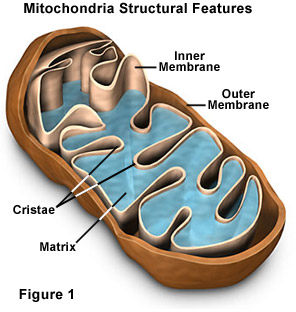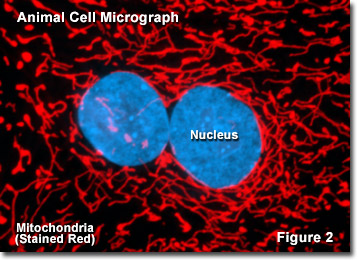Would An Animal Cell Be Able To Survive Without Mitochondria
Mitochondria
Mitochondria are rod-shaped organelles that can exist considered the power generators of the cell, converting oxygen and nutrients into adenosine triphosphate (ATP). ATP is the chemical energy "currency" of the cell that powers the cell's metabolic activities. This process is called aerobic respiration and is the reason animals exhale oxygen. Without mitochondria (atypical, mitochondrion), higher animals would likely not exist because their cells would only be able to obtain energy from anaerobic respiration (in the absence of oxygen), a process much less efficient than aerobic respiration. In fact, mitochondria enable cells to produce 15 times more ATP than they could otherwise, and complex animals, like humans, need large amounts of free energy in order to survive.

The number of mitochondria present in a cell depends upon the metabolic requirements of that prison cell, and may range from a single large mitochondrion to thousands of the organelles. Mitochondria, which are found in almost all eukaryotes, including plants, animals, fungi, and protists, are large plenty to be observed with a light microscope and were start discovered in the 1800s. The name of the organelles was coined to reflect the way they looked to the commencement scientists to discover them, stemming from the Greek words for "thread" and "granule." For many years subsequently their discovery, mitochondria were ordinarily believed to transmit hereditary information. It was non until the mid-1950s when a method for isolating the organelles intact was adult that the mod agreement of mitochondrial office was worked out.
The elaborate construction of a mitochondrion is very important to the performance of the organelle (see Figure 1). Two specialized membranes encircle each mitochondrion present in a cell, dividing the organelle into a narrow intermembrane space and a much larger internal matrix, each of which contains highly specialized proteins. The outer membrane of a mitochondrion contains many channels formed by the poly peptide porin and acts like a sieve, filtering out molecules that are too large. Similarly, the inner membrane, which is highly convoluted so that a large number of infoldings chosen cristae are formed, also allows just sure molecules to laissez passer through information technology and is much more selective than the outer membrane. To make certain that only those materials essential to the matrix are allowed into it, the inner membrane utilizes a group of transport proteins that will simply transport the correct molecules. Together, the various compartments of a mitochondrion are able to work in harmony to generate ATP in a complex multi-step process.
Mitochondria are by and large oblong organelles, which range in size between one and ten micrometers in length, and occur in numbers that direct correlate with the prison cell'south level of metabolic activity. The organelles are quite flexible, notwithstanding, and time-lapse studies of living cells accept demonstrated that mitochondria change shape rapidly and move near in the cell almost constantly. Movements of the organelles appear to be linked in some way to the microtubules present in the cell, and are probably transported along the network with motor proteins. Consequently, mitochondria may be organized into lengthy traveling chains, packed tightly into relatively stable groups, or announced in many other formations based upon the particular needs of the cell and the characteristics of its microtubular network.

Presented in Effigy 2 is a digital epitome of the mitochondrial network establish in the ovarian tissue from a mountain goat relative, known as the Himalayan Tahr, equally seen through a fluorescence optical microscope. The all-encompassing intertwined network is labeled with a synthetic dye named MitoTracker Red (ruby fluorescence) that localizes in the respiring mitochondria of living cells in culture. The rare twin nuclei in this jail cell were counterstained with a blue dye (cyan fluorescence) to denote their centralized location in relation to the mitochondrial network. Fluorescence microscopy is an important tool that scientists utilise to examine the construction and role of internal cellular organelles.
The mitochondrion is different from most other organelles considering it has its own circular Dna (like to the DNA of prokaryotes) and reproduces independently of the prison cell in which it is institute; an apparent example of endosymbiosis. Scientists hypothesize that millions of years ago modest, costless-living prokaryotes were engulfed, merely not consumed, by larger prokaryotes, perhaps because they were able to resist the digestive enzymes of the host organism. The two organisms developed a symbiotic relationship over time, the larger organism providing the smaller with ample nutrients and the smaller organism providing ATP molecules to the larger one. Somewhen, according to this view, the larger organism developed into the eukaryotic prison cell and the smaller organism into the mitochondrion.
Mitochondrial DNA is localized to the matrix, which also contains a host of enzymes, too as ribosomes for protein synthesis. Many of the critical metabolic steps of cellular respiration are catalyzed past enzymes that are able to diffuse through the mitochondrial matrix. The other proteins involved in respiration, including the enzyme that generates ATP, are embedded inside the mitochondrial inner membrane. Infolding of the cristae dramatically increases the surface area available for hosting the enzymes responsible for cellular respiration.
Mitochondria are similar to plant chloroplasts in that both organelles are able to produce energy and metabolites that are required by the host cell. As discussed above, mitochondria are the sites of respiration, and generate chemical free energy in the grade of ATP by metabolizing sugars, fats, and other chemical fuels with the assist of molecular oxygen. Chloroplasts, in contrast, are found only in plants and algae, and are the main sites of photosynthesis. These organelles work in a different mode to convert free energy from the sunday into the biosynthesis of required organic nutrients using carbon dioxide and h2o. Like mitochondria, chloroplasts also contain their own DNA and are able to abound and reproduce independently within the cell.
In well-nigh animate being species, mitochondria appear to be primarily inherited through the maternal lineage, though some recent evidence suggests that in rare instances mitochondria may besides be inherited via a paternal route. Typically, a sperm carries mitochondria in its tail equally an energy source for its long journey to the egg. When the sperm attaches to the egg during fertilization, the tail falls off. Consequently, the just mitochondria the new organism usually gets are from the egg its mother provided. Therefore, unlike nuclear Deoxyribonucleic acid, mitochondrial Deoxyribonucleic acid doesn't get shuffled every generation, so information technology is presumed to change at a slower rate, which is useful for the study of human evolution. Mitochondrial DNA is also used in forensic scientific discipline as a tool for identifying corpses or body parts, and has been implicated in a number of genetic diseases, such as Alzheimer's disease and diabetes.
Back TO Beast Jail cell STRUCTURE
BACK TO PLANT Jail cell Construction
Questions or comments? Send usa an email.
© 1995-2022 past Michael Westward. Davidson and The Florida State Academy. All Rights Reserved. No images, graphics, software, scripts, or applets may be reproduced or used in any way without permission from the copyright holders. Employ of this website means you hold to all of the Legal Terms and Conditions gear up along by the owners.
This website is maintained by our
Graphics & Web Programming Team
in collaboration with Optical Microscopy at the
National High Magnetic Field Laboratory.
Final modification: Friday, November thirteen, 2015 at 02:18 PM
Access Count Since October 1, 2000: 2219154
Microscopes provided past:
Source: https://micro.magnet.fsu.edu/cells/mitochondria/mitochondria.html
Posted by: croninknines.blogspot.com

0 Response to "Would An Animal Cell Be Able To Survive Without Mitochondria"
Post a Comment